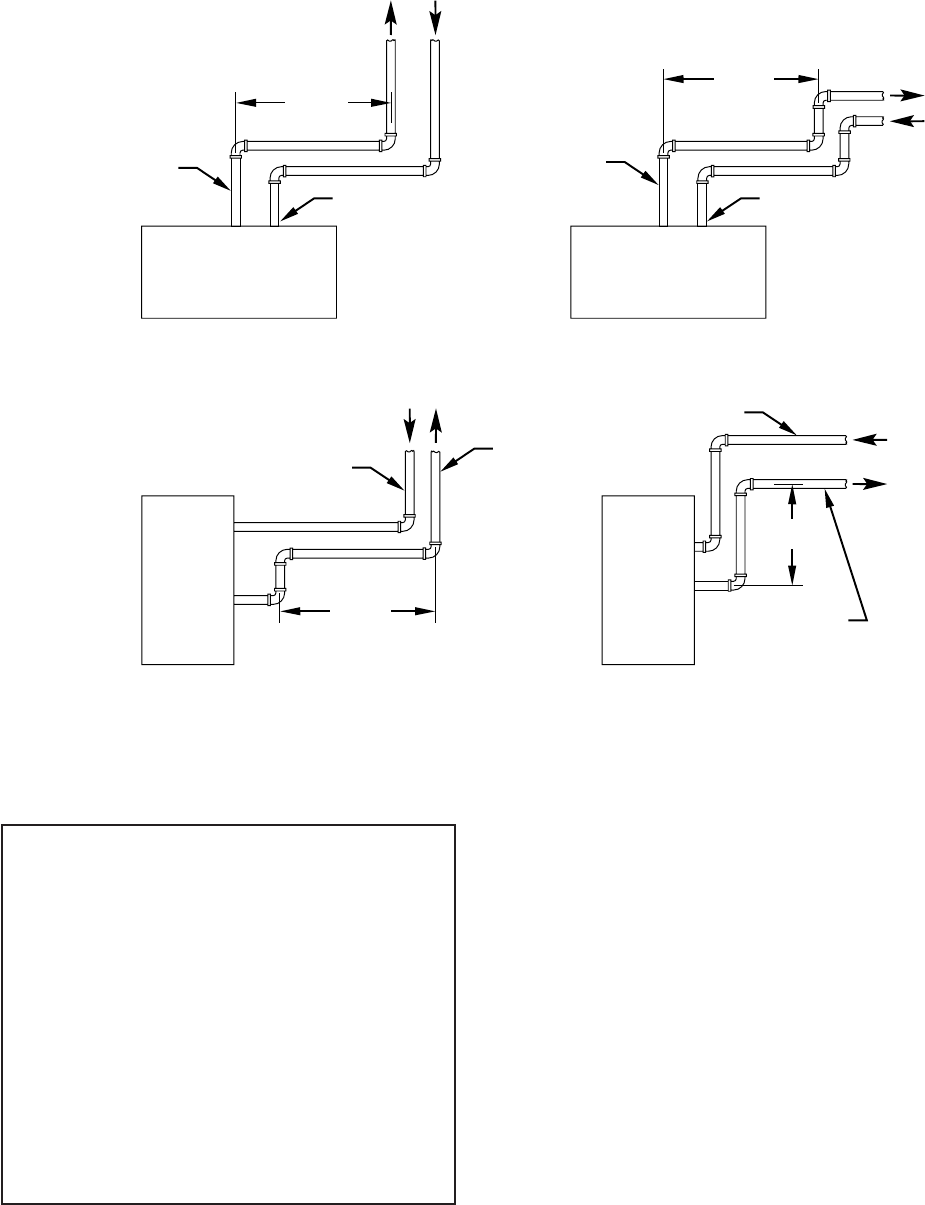Operating instructions

EXAMPLE:
An 036080 size furnace located in Indianapolis, elevation
650 ft above sea level, could be installed in an application
requiring 3 elbows and 32 ft of vent pipe, along with 5
elbows and 34 ft of combustion-air pipe. Table 7 indicates
this application would allow a 2-in. diameter vent pipe, but
require a 2-1/2 in. diameter combustion air pipe (2-in. pipe
is good for 35 ft with 3 elbows, but only 30 ft with 5
elbows). Therefore, 2-1/2 in. diameter pipe must be used
for both vent and combustion-air pipes since larger required
diameter must always be used for both pipes. If same
installation were in Albuquerque, elevation 5250 ft above
sea level, installation would require 2-1/2 in. vent pipe and
combustion-air pipe. At 5001- to 6000-ft elevation, 2-in.
pipe is only good for 17 ft with 5 elbows, and 2-1/2 in. pipe
is good for 70 ft with 5 elbows.
COMBUSTION-AIR AND VENT PIPE ATTACHMENT
NOTE: All pipe joints must be cemented except attachment of
combustion-air pipe to inlet housing connection, since it may be
necessary to remove pipe for servicing.
1. Attach combustion-air pipe as follows:
a. Determine location of combustion-air intake pipe con-
nection to combustion-air intake housing as shown in
Fig. 33 for application.
b. Reposition combustion-air intake housing plug fitting in
appropriate unused intake housing connection.
c. If required per Table 7, insert perforated disk assembly
(factory-supplied in loose parts bag) in intake housing
where combustion-air intake pipe will be connected. If
half disk set is required, install with shoulder of disk
against stop in combustion-air inlet.
d. Install pipe support (factory-supplied in loose parts bag)
into selected furnace casing combustion-air pipe hole.
Pipe support should be positioned at bottom of casing
hole.
e. Insert 2-in. diameter pipe into intake housing.
NOTE: A 2-in. diameter pipe must be used within the furnace
casing. Make all pipe diameter transitions outside furnace casing.
f. Install casing hole filler cap (factory-supplied in loose
parts bag) in unused combustion-air pipe casing hole.
g. Drill a 1/8-in. hole in 2-in. combustion-air pipe using
hole in intake housing as a guide.
h. Install a field-supplied No. 6 or No. 8 sheet metal screw
into combustion-air pipe.
NOTE: DO NOT OVERTIGHTEN SCREW. Breakage of intake
housing or fitting may cause air leakage to occur.
NOTE: Do not attach combustion-air intake pipe permanently to
combustion-air intake housing since it may be necessary to remove
pipe for service of igniter or flame sensor.
Fig. 34—Short Vent (5 to 8 Ft) System
A96230
HORIZONTAL TO ROOF HORIZONTAL TO SIDEWALL
VERTICAL TO SIDEWALLVERTICAL TO ROOF
VENT PIPE
COMBUSTION-AIR PIPE COMBUSTION-AIR PIPE
VENT PIPE
COMBUSTION-AIR PIPE
VENT PIPE
COMBUSTION-AIR PIPE
VENT PIPE
12″ MIN
12″ MIN
12″ MIN
12″ MIN
NOTE
: A 12 In. minimum offset pipe section is recommended with
short (5 to 8 ft) vent systems. This recommendation is to reduce
excessive condensate droplets from exiting the vent pipe.
—27—










